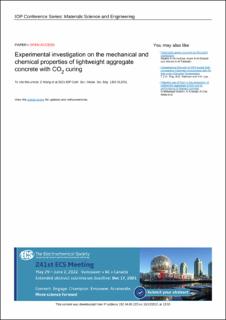| dc.contributor.author | Wang, Zihao | |
| dc.contributor.author | Dehestani, Salar | |
| dc.contributor.author | Kakay, Samdar | |
| dc.contributor.author | Sha, Yanyan | |
| dc.date.accessioned | 2021-12-13T15:34:39Z | |
| dc.date.available | 2021-12-13T15:34:39Z | |
| dc.date.created | 2021-12-08T11:10:45Z | |
| dc.date.issued | 2021 | |
| dc.identifier.citation | Wang, Z., Dehestani, S., Kakay, S., Sha, Y. (2021) Experimental investigation on the mechanical and chemical properties of lightweight aggregate concrete with CO2 curing. Experimental investigation on the mechanical and chemical properties of lightweight aggregate concrete with CO2 curing, 1201, 012051 | en_US |
| dc.identifier.issn | 1757-8981 | |
| dc.identifier.uri | https://hdl.handle.net/11250/2834048 | |
| dc.description.abstract | In the cement and concrete industry, enormous amounts of Carbon Dioxide (CO2) are emitted during their production processes. Carbon dioxide emission significantly contributes to the global climate change, which has been one of the biggest challenges of our times. Some novel solutions have been proposed for CO2 capture and storage, as well as reducing CO2 emission in concrete production. Carbonation curing is an effective alternative for conventional water curing for concrete. It can store CO2 in the hardened concrete and meanwhile improve early mechanical properties of concrete. Partial replacement of cement with fly ash shows environmental benefits, such as reducing greenhouse gas emissions and industrial waste destined for landfills. There has been some previous research studying on the effect of carbonation curing on normal Portland concrete in the past decade. Nevertheless, few studies have focused on the CO2 curing for lightweight aggregate concrete (LWAC). In this paper, the influence of early carbonation curing on LWAC is studied. LWAC specimens with two different water-to-cement ratios are cast and cured for a series of experimental investigations. The mechanical and chemical properties including the 1-day compressive strength, 28-day compressive strength, flexural strength, CO2 uptake, heat development, and pH level are investigated. Specimens with ordinary Portland cement are also tested as references in terms of compressive strength and CO2 uptake. | en_US |
| dc.language.iso | eng | en_US |
| dc.publisher | IOP Publishing | en_US |
| dc.rights | Navngivelse 4.0 Internasjonal | * |
| dc.rights.uri | http://creativecommons.org/licenses/by/4.0/deed.no | * |
| dc.title | Experimental investigation on the mechanical and chemical properties of lightweight aggregate concrete with CO2 curing | en_US |
| dc.type | Peer reviewed | en_US |
| dc.type | Journal article | en_US |
| dc.description.version | publishedVersion | en_US |
| dc.subject.nsi | VDP::Teknologi: 500 | en_US |
| dc.source.volume | 1201 | en_US |
| dc.source.journal | IOP Conference Series: Materials Science and Engineering | en_US |
| dc.identifier.doi | 10.1088/1757-899X/1201/1/012051 | |
| dc.identifier.cristin | 1966081 | |
| dc.source.articlenumber | 012051 | en_US |
| cristin.ispublished | true | |
| cristin.fulltext | original | |
| cristin.qualitycode | 1 | |

